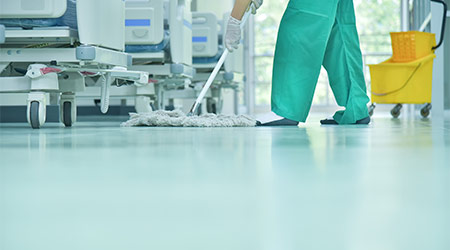The scrutiny on environmental services has never been more intense. Since the COVID-19 pandemic started nearly a year ago, the demand has grown for floor sanitization and disinfection services within healthcare facilities and other commercial and institutional spaces where large numbers of people gather.
While the treatments are not new, they are being applied more frequently and in greater quantities. As a result, facility managers and the general public have had more questions about the long-term effects of treating soft and hard floor surfaces, according to Floor Daily.
When flooring disinfection services are needed, managers should consider the services of a professional contractor to do the work. In-house staff or building maintenance can take care of the routine tasks, such as wiping down door knobs, faucet handles or surfaces that occupants touch regularly and repeatedly.
The processes used to disinfect floors are many and varied and include things like fogging or electrostatic spraying and use chemicals like bleach, oxidizers and quaternary ammonium compounds. The products should be hospital-grade disinfectants listed on the U.S. Environmental Protection Agency’s N, list, which meet the EPA and Centers for Disease Control and Prevention’s efficacy requirements against the novel coronavirus, meaning they kill 99.999 percent of bacteria and viruses on contact and are safe in all environments and on all surfaces.
Click here to read the article.

 Contaminants Under Foot: A Closer Look at Patient Room Floors
Contaminants Under Foot: A Closer Look at Patient Room Floors Power Outages Largely Driven by Extreme Weather Events
Power Outages Largely Driven by Extreme Weather Events Nemours Children's Health Opens New Moseley Foundation Institute Hospital
Nemours Children's Health Opens New Moseley Foundation Institute Hospital Code Compliance Isn't Enough for Healthcare Resilience
Code Compliance Isn't Enough for Healthcare Resilience Ribbon Cutting Marks First Phase Completion for New Montefiore Einstein Facility
Ribbon Cutting Marks First Phase Completion for New Montefiore Einstein Facility